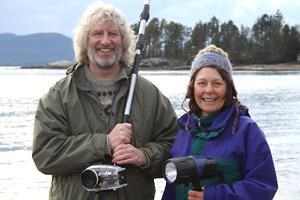For the first time in BC waters, Pacific sand lance have been captured on video spawning at Palm Beach.
Terry Brown and his partner Jude Abrams, naturalists and videographers, discovered the spawning forage fish while on a walk along Palm Beach in November. Brown waded into the water with gumboots on and saw the spinning ball of hundreds of sand lance coming together to kick up sand and create spawning grounds. Next time they went for a walk they made sure to bring the camera.
With a video camera in waterproof casing on the end of a pole, Brown and Abrams, over the course of three weeks, managed to capture the first video footage of sand lance spawning ever taken in BC. Footage has previously been captured in Puget Sound, Washington and spawning sites are known off Vancouver Island and the lower Sunshine Coast, but up until now the “wiggly fish,” as they are referred to in the video, have remained camera shy. Spawning grounds are usually discovered because of the presence of eggs, but to see the spawning in progress is a rare event.
Through Otter Be Good Productions, Brown’s audio and video production company, the video has been posted on YouTube under the title “Wiggly Fish: Spawning Sand Lance in BC” and, at the time of writing, has been viewed 156 times. That may not seem like an astounding number but the fact that most of those views are probably researchers and scientists, said Brown, means that the video is going viral among a certain crowd.
“We’re quite excited that we can play a part in discovering this and revealing it to people,” said Brown. “The researchers are really excited because they don’t have a lot to work with.”
Sand lance range from 10 to 50 per cent of many marine animal’s diets, according to information from the BC Shore Spawners Alliance. Adult chinook salmon’s diets consist of 50 per cent sand lance. A quarter of the Alaskan orca’s diet comes from forage fish, including the sand lance. The endangered marbled murrelet feeds its young with a diet of 85 per cent sand lance. Puffins, auklets, humpback whales, porpoises, cutthroat trout and other species also feed extensively on the fish.
Fisheries and Oceans Canada currently does not manage sand lance, as there is no fishing industry for the forage species. The alliance, a collection of community groups who work together to protect intertidal spawning grounds, has a mandate to pick up where the official agencies have left off. Since 2008 the alliance has been collecting data and dispensing advice on protecting spawning grounds and educating the public on the importance of forage fish.
Palm Beach is littered with logs and bark from the log sorts in Stillwater, situated just around the bend. The debris, along with public use of the beach, scours the sandy floor of the beach and harms the spawning grounds. The damming of Eagle River has also reduced the amount of sediment reaching the beach, material the fish rely on to plant their sand-grain-sized eggs.
Brown and Abrams are hoping to gather a group of locals to survey beaches, monitor spawning grounds and help protect the intertidal habitat. For more information or to get involved contact Brown at 604.487.0168 or [email protected].



